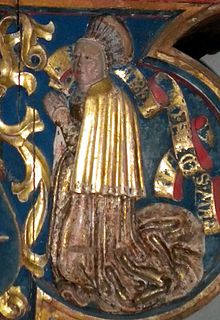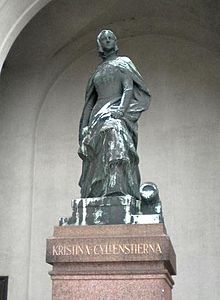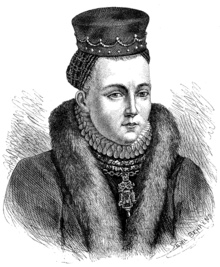- Christina Gyllenstierna
-
Kristina Nilsdotter Gyllenstierna (1494–1559), 16th century sculpture by the altar of Västerås Cathedral

Christina (Kristina or Kerstin) Nilsdotter of Fogelvik, Heiress of Tullgarn (1494/5 – January 1559), was the wife of the Swedish regent Sten Sture the Younger, and after his death, leader of resistance to Christian II of Denmark. In her lifetime she was called Lady Kristina (Swedish: Fru Kristina), but later was referred to as "Kristina Gyllenstierna" because of the house of nobility to which she belonged.
Contents
Background
Christina was a great-granddaughter of King Charles VIII of Sweden through her father, a younger son of Christina Karlsdotter Bonde, for whom Christina was named. In 1511, she was married to Sten Svantesson partly to strengthen his political position.
She was from a family of Danish origin. Her grandfather Erik Eriksen of Demstrup ("Gyldenstjerne") was Danish, but became acquainted with Sweden, because the two realms were united in the Kalmar Union. When Sweden and Denmark began to fight over control of the Union, Erik allied with the Swedish claimant, Charles VIII. As reward, Charles's daughter, the heir of Fogelvik, was married to him and he ultimately became the High Steward of Charles' court.
Christina's mother was Sigrid Eskilsdotter (Banér) of Venngarn, Heir of Lindholm; Christina was the half-sister of Cecilia Månsdotter of Eka, mother of the future king Gustav I, through her mother's other marriage. Her father was Niels Eriksen, Lord of Tullgarn (also written Nils Eriksson, and surnamed "Gyllenstjerna" by later historians). Christina's family belonged to the highest Swedish nobility of this "Regency" era.
During this period, Sweden was governed almost continuously by "Regents", first for the infant son of Charles VIII, and then simply in opposition to Danish authority under the Union. Sten's father Svante Nilsson was Regent from 1504–1512. At his death, Sten, then only 18, became Regent. He took the name "Sture" in honor of a previous Regent.
It is likely that Christina acted as political advisor to her spouse. The couple was regarded as king and queen in all but name. In 1519, Peder Månsson, Bishop of Västerås, expressed his surprise in a letter from Rome to the Abbess of Vadstena Abbey that Sture and Christina was not yet crowned. The same year, the authorities of Stockholm referred to Christina as "Our Dear Princess".
Danish invasion
In 1520, Sven was killed in battle against Christian II of Denmark, and the Privy Council of Sweden submitted to Christian II.
Christina took command of the Swedish forces and held out stoutly at Stockholm. The peasantry of central Sweden, roused by her patriotism, flew to arms and defeated the Danish invaders at Balundsås on March 19. and were only with the utmost difficulty finally defeated at the bloody battle of Uppsala, on April 6. Christina was now elected "King" by ten councillors of state in Uppsala.[1]
In May the Danish fleet arrived, and Stockholm was besieged by land and sea. But Christina resisted valiantly for four months longer. She surrendered on September 7 after great starvation and suffering in the city. She took care to exact beforehand an amnesty of the most explicit and absolute character for all acts of resistance to Denmark. King Christian promised, that "Everything from the past will be forgotten", that she would be granted the fief Tavastehus in Finland and that neither she nor her family would be punished.
During all this, Anna Eriksdotter (Bielke) defended and commanded the city of Kalmar in the same fashion.
After the defeat
On November 1, Christian crowned himself king of Sweden and invited the nobility to great festivities to celebrate the coronation. At a grand ball, he even danced with Christina. The festivities lasted for three days.
On November 7, Christian summoned the Swedish nobility to a meeting. Lady Christina, as well as several other influential women, were also invited. When they arrived, the doors were shut and guards set in place. Christian accused them all of deposing the pro-Danish Archbishop Gustav Trolle. He specifically accused Sten Sture as responsible for this, and directed his accusation toward Christina. Lady Christina stepped forward and stated that the king could not punish them for this, nor could he accuse her late spouse and her for having performed the deposition alone: everyone in the room had signed the bill of deposition, the removal of Archbishop Trolle had been a part of the rebellion, and Christian had pledged amnesty to everyone involved in the rebellion.
"We have proof," she added, "the document is here." At this, the document with the signatures of everyone supporting the deposition of the Archbishop was brought forward. But Christian had found a loophole, which the Swedes had overlooked. The deposition of a bishop was also a crime against the church - heresy - and the king had no authority to pardon them for that. So he could punish them without violating his pledge.
Christian then took his revenge, known as the Stockholm Bloodbath. Christina's brother Erik Nilsson, Lord of Tullgarn, was executed by beheading, as were many other Swedish magnates. Christina inherited Tullgarn, little benefit as it then did her. Her husband's remains were exhumed and burned publicly at the stake as a heretic.
Christina was declared a great traitor and rebel, and as such King Christian called upon her and publicly asked her to choose: which did she prefer, to be burned at the stake or to be buried alive? Confronted with this choice, Christina was unable to reply and fainted with horror. After this, Christian was advised to spare her life. To save her life, she ceded a large part of her property to Christian. Christina's mother Sigrid was sentenced to be drowned (the only woman condemned to death), but avoided execution by surrendering all her estates.
Christina, her mother, her half sister and other noble ladies of Sweden were imprisoned in the feared and infamous Blåtårn ("Blue Tower") of Copenhagen Castle. Christina had the company of her two little sons in the prison.
However, Danish rule in Sweden was soon overthrown by Gustav Vasa, and in 1523 the Danes themselves deposed Christian. In 1525, the two countries made peace and Christina was released to return to Sweden. At this time, she received a proposal of marriage from Søren Norby, Grand Admiral of Denmark, which she turned down. It was rumored that she had intended to marry Norrby as a means to gain the Swedish throne for herself and her children. Gustav Vasa interrogated her about this, but she denied it.
Later life and family
In 1527 Christina remarried, to Johan Turesson, Lord of Falun. Gustav Vasa saw her as a threat when she first returned, as she was as great a national symbol as he was. This marriage was arranged as a form of retirement for her; she thereby promised not to involve herself further in politics.
In 1527, a rebellion broke out in Dalarna in opposition to Gustav's introduction of the Protestant Reformation to Sweden. The leader of the rebellion was the so-called Daljunkern ("the youngster from Dalarna"), who claimed to be Nils Sture, the 15-year-old elder son of Sten and Christina. Gustav defeated the rebels, and Daljunkern fled to Norway and then Germany, where he was arrested and executed by Gustav's order. Gustav had Christina write a statement where she declared that Daljunkern was not her son but "To my knowledge a thief and impostor." According to Gustav's official history, Nils had died a year earlier. But some modern historians think that Nils may have been Daljunkern.
Christina was briefly made responsible for the court of the royal children between the death of queen Margaret Leijonhufvud in 1551 and the king's marriage to queen Katarina Stenbock in 1552.
Christina had two sons from her first marriage: Nils and Svante Sture. From her second marriage, she had a son, Gustaf Johansson. Eric XIV made Svante Count of Vestervik and Stegeholm, and at the same time made Gustaf Count of Enköping (later changed to county of Bogesund). Through daughters of these two counts, Christina became within a century an ancestress of most of Sweden's highest nobility.[2] Her distant direct descendant, Sibylla of Saxe-Coburg-Gotha married Prince Gustav Adolf, Duke of Västerbotten, and with Sibylla's son, King Carl XVI Gustaf of Sweden, Christina's blood returned to the Swedish throne.
See also
Notes
- ^ Gert Z. Nordström: Stockholms blodbad, ("Stockholm's Bloodbath")
- ^ Descendants of Christina Gyllenstierna at Genealogics
References
- Lindqvist, Herman. Historien om Sverige, ("The History of Sweden")
- Ohlmarks, Åke. Alla Sveriges drottningar ("All the queens of Sweden")
- Svenskt Biografiskt Lexikon (SBL), cd-skiva, band 17 (Swedish biogrphical Dictionary)
Christina GyllenstiernaBorn: 1494 Died: January 1559Swedish royalty Preceded by
Mette DyreRegent consort of Sweden
1512–1520Succeeded by
Isabella of Austria
as Queen consortSwedish Royal Consorts Silvia Renate Sommerlath (1976–present)
Louise Mountbatten (1950–1965) · Victoria of Baden (1907–1930) · Sophia of Nassau* (1872–1907) · Louise of the Netherlands* (1859–1871) · Josephine of Leuchtenberg* (1844–1859) · Désirée Clary* (1818–1844) · Hedvig Elisabeth Charlotte of Holstein-Gottorp* (1809–1818) · Frederica of Baden (1797–1809) · Sophia Magdalena of Denmark (1771–1792) · Louisa Ulrika of Prussia (1751–1771) · Ulrika Eleonora (1720–1741) · Frederick of Hesse-Kassel (1718/1719–1720) · Ulrika Eleonora of Denmark (1680–1693) · Hedvig Eleonora of Holstein-Gottorp (1654–1660) · Maria Eleonora of Brandenburg (1620–1632) · Christina of Holstein-Gottorp (1599/1604–1611) · Anne of Austria (1592–1598) · Gunilla Bielke (1585–1592) · Catherine Jagellon (1568–1583) · Karin Månsdotter (1567–1568) · Catherine Stenbock (1552–1560) · Margaret Leijonhufvud (1536–1551) · Catherine of Saxe-Lauenburg (1531–1533) · Isabella of Austria*^ (1520–1521) · Christina Gyllenstierna (1512–1520) · Mette Dyre (1504–1512) · Ingeborg Tott (1501–1503) · Christina of Saxony*^ (1497–1501) · Ingeborg Tott (1470–1497) · Christina Abrahamsdotter (1470) · Elin Gustavsdotter (Sture) (1466–1467) · Dorothea of Brandenburg*^ (1457–1464) · Catherine Karlsdotter (1448–1450) · Merete Lydekedatter (1448) · Karin Karlsdotter (1448) · Dorothea of Brandenburg*^ (1445–1448) · Philippa of England*^ (1406–1430) · Richardis of Schwerin (1365–1377) · Margareta Valdemarsdotter* (1363–1364) · Beatrice of Bavaria (1356–1359) · Blanche of Namur (1335–1363) · Märta Eriksdotter (1298–1318) · Hedwig of Holstein (1276–1290) · Sophia Eriksdotter (1260–1275) · Catherine Sunadotter (1243/1244–1250) · Helena Pedersdatter Strange (1229–1234) · Richeza of Denmark (1210–1216) · Ingegerd Birgersdotter (1200–1208) · Benedicta Ebbesdotter (1196–1199/1200) · Cecilia Johansdotter (1167–1190) · Christina Stigsdatter (1163/1164–1167) · Brigida Haraldsdotter (1160–1161) · Christina Björnsdatter (1156–1160) · Richeza of Poland (1148–1156) · Ulvhild Håkansdotter^ (1134–1148) · Richeza of Poland (1127–1130) · Ulvhild Håkansdotter^ (1117–1125) · Ragnhild Halstensdotter (1105–1117) · Ingegerd of Norway^ (1105–1118) · Helena (1088–1105) · Blotstulka (1084–1087) · Helena (1079–1084) · Gyla (1066–1067 & 1075–1079) · Astrid Njalsdotter (1050–1060) · Gunnhildr Sveinsdóttir^ (1022–1050) · Estrid of the Obotrites (1000–1022) · Aud Haakonsdottir of Lade (990s–995) · Świętosława of Poland*^ (late 10th century)*also Queen of Norway
^also Queen of DenmarkCategories:- Swedish nobility
- 1494 births
- 1559 deaths
- Women in 16th-century warfare
- Rebels
- Women of medieval Sweden
- 16th-century Swedish people
- 16th-century women
- People of the Swedish War of Liberation
Wikimedia Foundation. 2010.



